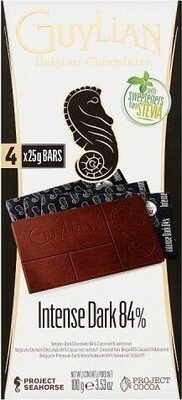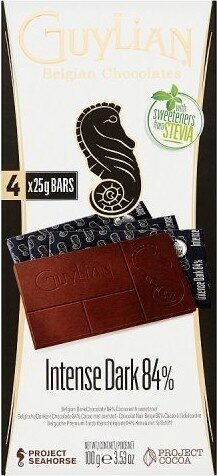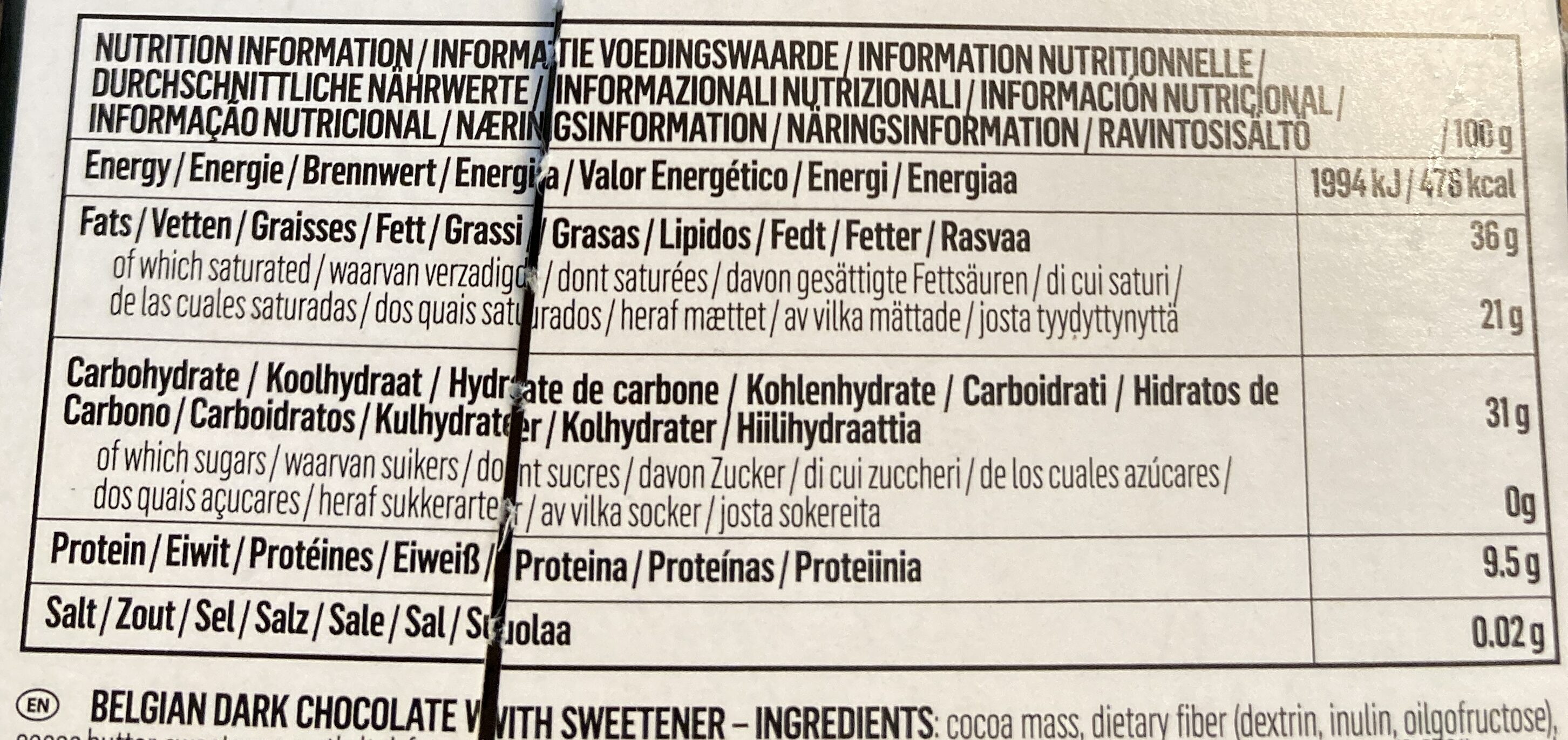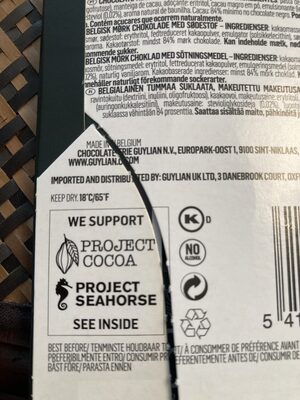Help us make food transparency the norm!
As a non-profit organization, we depend on your donations to continue informing consumers around the world about what they eat.
The food revolution starts with you!
Belgian Chocolates Intense Dark 84% Bars 4 x (100g) - Guylian - 100 g
Belgian Chocolates Intense Dark 84% Bars 4 x (100g) - Guylian - 100 g
Barcode: 5410976821014 (EAN / EAN-13)
Quantity: 100 g
Packaging: Paper
Brands: Guylian
Categories: Snacks, Sweet snacks, Cocoa and its products, Confectioneries, Bars, Chocolate candies, Chocolates, Dark chocolates, Candy chocolate bars
Labels, certifications, awards: Excessive consumption can have laxative effects, No added sugar, Une consommation excessive peut avoir des effets laxatifs
Origin of ingredients: Made in Belgium
Countries where sold: France, Germany, New Zealand
Matching with your preferences
Health
Ingredients
-
14 ingredients
French: Pâte de cacao, fibre alimentaire (dextrine, inuline, oligofructose), beurre de cacao, édulcorant : érythritol, cacao maigre en poudre, émulsifiant (lécithine de tournesol), édulcorant : glycosides de stéviol (0,02%), arôme naturel de vanille.Allergens: Gluten, Soybeans
Food processing
-
Ultra processed foods
Elements that indicate the product is in the 4 - Ultra processed food and drink products group:
- Additive: E1400 - Dextrin
- Additive: E322 - Lecithins
- Additive: E960 - Steviol glycosides
- Additive: E968 - Erythritol
- Ingredient: Emulsifier
- Ingredient: Flavouring
- Ingredient: Sweetener
Food products are classified into 4 groups according to their degree of processing:
- Unprocessed or minimally processed foods
- Processed culinary ingredients
- Processed foods
- Ultra processed foods
The determination of the group is based on the category of the product and on the ingredients it contains.
Additives
-
E1400 - Dextrin
Dextrin: Dextrins are a group of low-molecular-weight carbohydrates produced by the hydrolysis of starch or glycogen. Dextrins are mixtures of polymers of D-glucose units linked by α--1→4- or α--1→6- glycosidic bonds. Dextrins can be produced from starch using enzymes like amylases, as during digestion in the human body and during malting and mashing, or by applying dry heat under acidic conditions -pyrolysis or roasting-. The latter process is used industrially, and also occurs on the surface of bread during the baking process, contributing to flavor, color and crispness. Dextrins produced by heat are also known as pyrodextrins. The starch hydrolyses during roasting under acidic conditions, and short-chained starch parts partially rebranch with α--1‚6- bonds to the degraded starch molecule. See also Maillard Reaction. Dextrins are white, yellow, or brown powders that are partially or fully water-soluble, yielding optically active solutions of low viscosity. Most of them can be detected with iodine solution, giving a red coloration; one distinguishes erythrodextrin -dextrin that colours red- and achrodextrin -giving no colour-. White and yellow dextrins from starch roasted with little or no acid are called British gum.Source: Wikipedia
-
E322 - Lecithins
Lecithins are natural compounds commonly used in the food industry as emulsifiers and stabilizers.
Extracted from sources like soybeans and eggs, lecithins consist of phospholipids that enhance the mixing of oil and water, ensuring smooth textures in various products like chocolates, dressings, and baked goods.
They do not present any known health risks.
-
E322i - Lecithin
Lecithins are natural compounds commonly used in the food industry as emulsifiers and stabilizers.
Extracted from sources like soybeans and eggs, lecithins consist of phospholipids that enhance the mixing of oil and water, ensuring smooth textures in various products like chocolates, dressings, and baked goods.
They do not present any known health risks.
-
E960 - Steviol glycosides
Steviol glycoside: Steviol glycosides are the chemical compounds responsible for the sweet taste of the leaves of the South American plant Stevia rebaudiana -Asteraceae- and the main ingredients -or precursors- of many sweeteners marketed under the generic name stevia and several trade names. They also occur in the related species Stevia phlebophylla -but in no other species of Stevia- and in the plant Rubus chingii -Rosaceae-.Steviol glycosides from Stevia rebaudiana have been reported to be between 30 and 320 times sweeter than sucrose, although there is some disagreement in the technical literature about these numbers. They are heat-stable, pH-stable, and do not ferment. Additionally, they do not induce a glycemic response when ingested, because humans can not metabolize stevia. This makes them attractive as natural sugar substitutes for diabetics and other people on carbohydrate-controlled diets. Steviol glycosides stimulate the insulin secretion through potentiation of the β-cell, preventing high blood glucose after a meal. The acceptable daily intake -ADI- for steviol glycosides, expressed as steviol equivalents, has been established to be 4 mg/kg body weight/day, and is based on no observed effects of a 100 fold higher dose in a rat study.Source: Wikipedia
-
E968 - Erythritol
Erythritol: Erythritol --2R,3S--butane-1‚2,3‚4-tetrol- is a sugar alcohol -or polyol- that has been approved for use as a food additive in the United States and throughout much of the world. It was discovered in 1848 by Scottish chemist John Stenhouse. It occurs naturally in some fruit and fermented foods. At the industrial level, it is produced from glucose by fermentation with a yeast, Moniliella pollinis. Erythritol is 60–70% as sweet as sucrose -table sugar- yet it is almost noncaloric, does not affect blood sugar, does not cause tooth decay, and is partially absorbed by the body, excreted in urine and feces. Under U.S. Food and Drug Administration -FDA- labeling requirements, it has a caloric value of 0.2 kilocalories per gram -95% less than sugar and other carbohydrates-, though nutritional labeling varies from country to country. Some countries, such as Japan and the United States, label it as zero-calorie; the European Union labels it 0 kcal/g.Source: Wikipedia
Ingredients analysis
-
Palm oil free
No ingredients containing palm oil detected
-
Vegan status unknown
Unrecognized ingredients: Fiber
-
Vegetarian status unknown
Unrecognized ingredients: Fiber
-
Details of the analysis of the ingredients
fr: Pâte de cacao, fibre alimentaire (dextrine, inuline, oligofructose), beurre de cacao, édulcorant (érythritol), cacao maigre en poudre, émulsifiant (lécithine de tournesol), édulcorant (glycosides de stéviol 0.02%), arôme naturel de vanille- Pâte de cacao -> en:cocoa-paste - vegan: yes - vegetarian: yes - ciqual_proxy_food_code: 16030 - percent_min: 12.5 - percent_max: 100
- fibre alimentaire -> en:fiber - percent_min: 0 - percent_max: 50
- dextrine -> en:e1400 - vegan: yes - vegetarian: yes - percent_min: 0 - percent_max: 50
- inuline -> en:inulin - vegan: yes - vegetarian: yes - percent_min: 0 - percent_max: 25
- oligofructose -> en:oligofructose - vegan: yes - vegetarian: yes - percent_min: 0 - percent_max: 16.6666666666667
- beurre de cacao -> en:cocoa-butter - vegan: yes - vegetarian: yes - ciqual_food_code: 16030 - percent_min: 0 - percent_max: 33.3333333333333
- édulcorant -> en:sweetener - percent_min: 0 - percent_max: 25
- érythritol -> en:e968 - vegan: yes - vegetarian: yes - percent_min: 0 - percent_max: 25
- cacao maigre en poudre -> en:fat-reduced-cocoa-powder - vegan: yes - vegetarian: yes - ciqual_food_code: 18100 - percent_min: 0 - percent_max: 20
- émulsifiant -> en:emulsifier - percent_min: 0 - percent_max: 16.6666666666667
- lécithine de tournesol -> en:sunflower-lecithin - vegan: yes - vegetarian: yes - percent_min: 0 - percent_max: 16.6666666666667
- édulcorant -> en:sweetener - percent_min: 0 - percent_max: 0.02
- glycosides de stéviol -> en:e960 - vegan: yes - vegetarian: yes - percent_min: 0.02 - percent: 0.02 - percent_max: 0.02
- arôme naturel de vanille -> en:natural-vanilla-flavouring - vegan: yes - vegetarian: yes - percent_min: 0 - percent_max: 0.02
Nutrition
-
Poor nutritional quality
⚠ ️Warning: the amount of fiber is not specified, their possible positive contribution to the grade could not be taken into account.⚠ ️Warning: the amount of fruits, vegetables and nuts is not specified on the label, it was estimated from the list of ingredients: 0This product is not considered a beverage for the calculation of the Nutri-Score.
Positive points: 0
- Proteins: 5 / 5 (value: 9.5, rounded value: 9.5)
- Fiber: 0 / 5 (value: 0, rounded value: 0)
- Fruits, vegetables, nuts, and colza/walnut/olive oils: 0 / 5 (value: 0, rounded value: 0)
Negative points: 15
- Energy: 5 / 10 (value: 1992, rounded value: 1992)
- Sugars: 0 / 10 (value: 0, rounded value: 0)
- Saturated fat: 10 / 10 (value: 21, rounded value: 21)
- Sodium: 0 / 10 (value: 8, rounded value: 8)
The points for proteins are not counted because the negative points are greater or equal to 11.
Nutritional score: (15 - 0)
Nutri-Score:
-
Nutrient levels
-
Fat in high quantity (36%)
What you need to know- A high consumption of fat, especially saturated fats, can raise cholesterol, which increases the risk of heart diseases.
Recommendation: Limit the consumption of fat and saturated fat- Choose products with lower fat and saturated fat content.
-
Saturated fat in high quantity (21%)
What you need to know- A high consumption of fat, especially saturated fats, can raise cholesterol, which increases the risk of heart diseases.
Recommendation: Limit the consumption of fat and saturated fat- Choose products with lower fat and saturated fat content.
-
Sugars in low quantity (0%)
What you need to know- A high consumption of sugar can cause weight gain and tooth decay. It also augments the risk of type 2 diabetes and cardio-vascular diseases.
Recommendation: Limit the consumption of sugar and sugary drinks- Sugary drinks (such as sodas, fruit beverages, and fruit juices and nectars) should be limited as much as possible (no more than 1 glass a day).
- Choose products with lower sugar content and reduce the consumption of products with added sugars.
-
Salt in low quantity (0.02%)
What you need to know- A high consumption of salt (or sodium) can cause raised blood pressure, which can increase the risk of heart disease and stroke.
- Many people who have high blood pressure do not know it, as there are often no symptoms.
- Most people consume too much salt (on average 9 to 12 grams per day), around twice the recommended maximum level of intake.
Recommendation: Limit the consumption of salt and salted food- Reduce the quantity of salt used when cooking, and don't salt again at the table.
- Limit the consumption of salty snacks and choose products with lower salt content.
-
-
Nutrition facts
Nutrition facts As sold
for 100 g / 100 mlCompared to: Candy chocolate bars Energy 1,992 kj
(476 kcal)-5% Fat 36 g +35% Saturated fat 21 g +42% Carbohydrates 31 g -45% Sugars 0 g -100% Fiber ? Proteins 9.5 g +51% Salt 0.02 g -93% Fruits‚ vegetables‚ nuts and rapeseed‚ walnut and olive oils (estimate from ingredients list analysis) 0 %
Environment
-
Eco-Score D - High environmental impact
⚠ ️Select a country in order to include the full impact of transportation.The Eco-Score is an experimental score that summarizes the environmental impacts of food products.→ The Eco-Score was initially developped for France and it is being extended to other European countries. The Eco-Score formula is subject to change as it is regularly improved to make it more precise and better suited to each country.Life cycle analysis
-
Average impact of products of the same category: D (Score: 35/100)
Category: Dark chocolate bar, less than 70% cocoa
Category: Dark chocolate bar, less than 70% cocoa
- PEF environmental score: 0.88 (the lower the score, the lower the impact)
- including impact on climate change: 16.88 kg CO2 eq/kg of product
Stage Impact Agriculture
88.5 %Processing
5.0 %Packaging
1.2 %Transportation
4.8 %Distribution
0.5 %Consumption
0.0 %
Bonuses and maluses
-
Missing origins of ingredients information
Malus: -5
⚠ ️ The origins of the ingredients of this product are not indicated.
If they are indicated on the packaging, you can modify the product sheet and add them.
If you are the manufacturer of this product, you can send us the information with our free platform for producers.
-
Packaging with a low impact
Malus: -1
Shape Material Recycling Impact Unknown Paper Low ⚠ ️ The information about the packaging of this product is not sufficiently precise (exact shapes and materials of all components of the packaging).⚠ ️ For a more precise calculation of the Eco-Score, you can modify the product page and add them.
If you are the manufacturer of this product, you can send us the information with our free platform for producers.
Eco-Score for this product
-
Impact for this product: D (Score: 29/100)
Product: Belgian Chocolates Intense Dark 84% Bars 4 x (100g) - Guylian - 100 g
Life cycle analysis score: 35
Sum of bonuses and maluses: -6
Final score: 29/100
-
Carbon footprint
-
Equal to driving 8.7 km in a petrol car
1688 g CO² per 100g of product
The carbon emission figure comes from ADEME's Agribalyse database, for the category: Dark chocolate bar, less than 70% cocoa (Source: ADEME Agribalyse Database)
Stage Impact Agriculture
94.1 %Processing
2.7 %Packaging
0.6 %Transportation
2.4 %Distribution
0.1 %Consumption
0.0 %
Packaging
-
Packaging with a low impact
-
Packaging parts
(Paper)
-
Packaging materials
Material % Packaging weight Packaging weight per 100 g of product Paper or cardboard
-
Transportation
-
Origins of ingredients
Missing origins of ingredients information
⚠ ️ The origins of the ingredients of this product are not indicated.
If they are indicated on the packaging, you can modify the product sheet and add them.
If you are the manufacturer of this product, you can send us the information with our free platform for producers.Add the origins of ingredients for this product Add the origins of ingredients for this product
Report a problem
-
Incomplete or incorrect information?
Category, labels, ingredients, allergens, nutritional information, photos etc.
If the information does not match the information on the packaging, please complete or correct it. Open Food Facts is a collaborative database, and every contribution is useful for all.
Data sources
Product added on by kiliweb
Last edit of product page on by lcmortensen.
Product page also edited by autorotate-bot, chevalstar, date-limite-app, ecoscore-impact-estimator, openfoodfacts-contributors, packbot, roboto-app, yuka.UUw4cklwUWVvNlJRcC9jbG9Cclc2dFJYM1piM0FVWHVEZVVOSVE9PQ, yuka.sY2b0xO6T85zoF3NwEKvlmAaXNTjvwDiEBDumBavm-6-dKzBR91x86n0Pas, yuka.sY2b0xO6T85zoF3NwEKvlmJ3cMb4_G7ZMzvSnHyK7diNcpW1aN5V4az8MKg.












